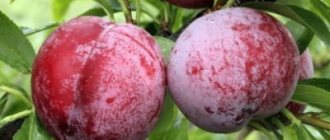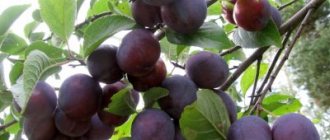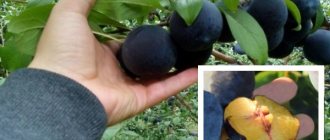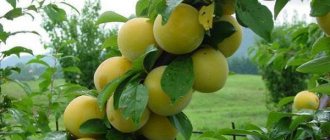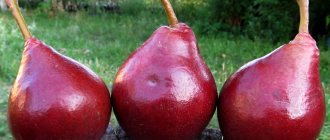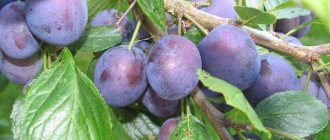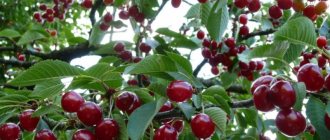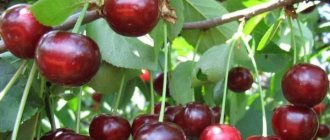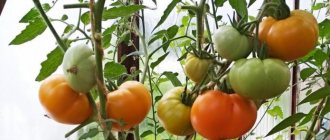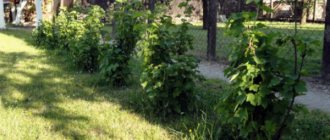Decorative varieties of plum
Of all the decorative species, the spreading plum, or cherry plum, deserves special attention. It is a compact tree of the Rosaceae family. The leaves of this plum are simple, ovate, pointed at the tip. Between the five petals are fluffy stamens, which give the flowers a special charm. The fruit is a juicy drupe with a sweet and sour taste.
The Nigra variety is very popular. This plum has dark purple leaves that appear almost black from a distance. This tree looks great against the background of plants with light and silvery foliage (linden, willow, plane tree, oleaster, sea buckthorn, shepherdia, etc.).
Pissardi plum is widely used in landscaping urban areas in the Crimea and on the Black Sea coast. Its dark purple or intense red leaves with a metallic sheen are decorative. In spring, pink flowers bloom on the tree, and dark cherry fruits appear in autumn.
A variety of splayed plum, Hesseya, is also popular. This shrub produces pale green leaves in the spring, eventually turning purplish-violet with an irregular cream or pink edge. In April-May, whitish-pink flowers appear on the plum tree.
Advantages and disadvantages
It is impossible to talk about Pissardi plum without mentioning its advantages and disadvantages.
Let's start with the best:
- The Pissardi plum, due to its unique appearance and early flowering, is an excellent decoration for the landscape. It has high decorative qualities and serves as a bright “necklace” of any area;
- the crop is not afraid of drought and air pollution;
- cherry plum withstands the attacks of many diseases;
- The variety is unpretentious in care and does not require special attention to its “person”.
The disadvantages include:
- fear of winds, drafts, frost and cold;
- the fruits of the cherry plum do not have good taste, so the tree is not so much a fruit as an ornamental one;
- the plant does not tolerate neighbors and requires a lot of space.
As you can see, decorating your own garden, summer cottage or lawn is quite easy. You just need to plant the colorful Pissardi plum. Such a bright culture with its purple contrasting appearance will help not only create an ideal landscape design, but also decorate everyday life. Moreover, caring for such a pupil will not be difficult.
Many fruit trees are grown in our country; every year they delight us with tasty and healthy berries and fruits. Their varieties naturally depend on the climatic conditions of the region.
The plum tree is very popular in our country - it can be found in almost every yard of a private house and even on city streets. Fruits can not only be eaten raw, but also used to prepare various desserts and dishes, as well as some traditional medicine.
The Pissardi plum tree is a fruit tree, comes from the Rosaceae family, and has fruits of various colors: from yellow to red, from blue to purple. The fruits have a sweet and sour taste. It is generally accepted that plums were developed in the Caucasus, Northern Iran and Asia Minor.
The famous scientist and botanist Pissardi brought the seedlings to Europe. Currently, gardeners in many countries around the world, which have not only temperate but also cold climates, are successfully cultivating plums. The tree can grow in dry areas if it receives sufficient water.
Growing red plum
It is difficult to formulate general growing conditions for such different varieties. But they differ mainly in frost resistance. The area for red-leaved plums should be taken with neutral acidity. The growing nettle, chamomile, and coltsfoot will point to it. It is better to sod the area with clover, bluegrass, and bentgrass. The fruits falling from the tree will not break. Weeds will not grow in such an area. The depth of groundwater is one and a half meters.
This way you can immediately see possible root defects: thickening, deformation, unevenness or injury. When purchasing seedlings with a closed root system, look at the drainage hole. Young roots should be peeking out of it. If they are not there, it is dangerous to take such a tree.
Buy one-year or two-year-old seedlings with an open root system in the fall. They are transported wrapped in a damp cloth and placed in polyethylene. In the southern regions they are planted in the fall, in the northern regions they are buried at an angle for storage until spring. Seedlings in pots can be purchased and planted in May-early June.
Features of planting a seedling:
- In the fall or a couple of weeks before planting, holes are prepared with a depth of 60 cm and a radius of 50 cm. Mix the excavated soil, 0.5 kg of superphosphate, and 2-3 buckets of humus. Fill the prepared hole to half the height. It sags until the seedling is planted. If this is not done, the soil will sag after planting, pulling the roots of the plant along with it and tearing them off.
- Prepare the seedling immediately before planting. Soak it in a clay mash, to which 2 tablets of the root former Heteroauxin were added.
- Place the seedling in the hole and straighten the roots. In the southern regions, the root collar is installed at the level of the hole, in the northern regions it is deepened by 3 cm. This will allow the tree to grow back after possible freezing.
- A peg for tying is installed next to the tree. Sprinkle the root system with the remaining soil. Water, compact. Tie the plant with twine to a peg. It will hold the plum for the first years until the trunk gets stronger.
- Pruning is carried out by shortening the branches by a third. This will cause side shoots to grow.
- Mulch the tree trunk circle to retain moisture in the root system. Humus, grass clippings, or even dry soil 10 cm thick are used as mulch.
More information can be found in the video:
For your information! In normal weather and climatic conditions and with well-designed agricultural technology, the plant forms an annual growth of 25 cm.
The leaf has an elliptical shape and is up to 6 cm long. The main varietal feature is a crimson or red color and a metallic sheen, which is atypical for the culture. The color remains unchanged throughout the growing season and even in autumn. The leaves are arranged alternately.
The variety begins flowering in April before foliage appears. The bush, like other plum plants, is densely covered with soft pink flowers with five petals. The process is completed in May, when the plant is already completely covered with foliage. Pollinating plants are important to Pissardi. They use Chinese plum, as well as Lama plum and other varieties of red-leaved crops, as well as cherry plum.
The fruits of the variety are drupes painted cherry color. They are 3 cm in diameter, and the weight varies between 20-30 g. Ripening begins in August, the fruits can be harvested until mid-autumn. Inside the fruit is an oblong oval-shaped bone. Plum has a specific sour-tart taste.
Preparation and planting
Since Pissardi is an unpretentious variety, you don’t need to put in a lot of effort for its planting and subsequent care - simple basics are enough, thanks to which high-quality growth and a rich, stable harvest will be ensured.
Place and dates
Pissardi is a very sun- and heat-loving plant. Plant trees on the south side of the garden, away from strong winds and drafts, and so that other trees do not cover this plum tree. Be sure to measure the groundwater level - its depth should not exceed 1.5 meters to the bottom of the hole, since Pissardi does not like excess moisture. If this cannot be avoided, then use expanded clay drainage.
Plant trees before the buds swell in the spring, this will give the plant a chance to take root in the soil before the onset of cold weather. But this does not mean that autumn is not suitable for planting. September is considered the best option, since the cuttings will also have time to adapt to environmental conditions.
Neighborhood of cultures
This variety is not able to grow too close to other plants, as it loves solitude and space around itself. Make sure that the tree is not surrounded by unfriendly neighbors. Only at a distance of 5 meters you can plant the following crops:
- berry bushes;
- evergreen tree options;
- apple trees
You cannot plant next to:
- red leaf raspberries;
- pear.
Selection and preparation of seedlings
Planting material of the variety is divided into self-rooted and grafted. When choosing between open and closed roots, choose the first option, as they are more developed and can take root and grow better.
Despite the fact that even large-sized ones (seedlings 5 years old and older) can be sold in nurseries, you should not rush to purchase them in the hope that this way you can get a harvest faster. A common occurrence is cut off roots in seedlings of this age, which indicates that they will take root for another couple of years and during this time younger seedlings will be able to catch up with them and overtake them in development.
When choosing a seedling, consider the following points:
Pay attention to the level of development of the root system. Plums aged 1-2 years should have from 3 to 5 main roots 25-30 cm long
The best choice of planting material occurs in the fall. If the seedlings were purchased in early autumn, then plant them immediately, without delaying until spring, and if in late autumn, then dig them in.
Boarding instructions
Planting a seedling does not require large investments or resources. You only need to have a standard set of tools and materials:
- shovel for holes;
- soil disintegrant;
- fertilizers;
- water;
- soft rope;
- a peg to tie up the cutting.
The landing process occurs in the following order:
- Prepare a hole measuring 50x70 cm (do this 2 weeks before planting), fill it with a fertile layer of soil that has already been mixed with compost and leave it in this state for 2 weeks.
- Install the landing stake.
- Place the seedling on the north side of the stake.
- Straighten the roots and place them in the hole so that the root collar is at a distance of 3-5 cm from the ground level, after which the roots can be covered with soil.
- Compact the ground.
- After completing the planting process, tie the plum to a stake, mulch the ground and water well.
Features of cultivation
First you need to decide on your growing goals and, in accordance with them, select a variety of splayed plum. It is better to purchase in specialized nurseries. It is necessary to give preference to varieties that are zoned in your region or with universal survival.
One-, two- and three-year-old seedlings, as well as large-sized trees (five-year-old trees), are offered for sale. Buying the latter in order to see the harvest faster is not always justified. It often happens that the roots of a plant are cut off when digging, so they need a longer period of time to restore and grow the cut-off part of the root. During this time, the two-year-old will more than have time to catch up and outstrip the five-year-old specimen that is restoring the root.
When buying a seedling, first of all you should pay attention to the rhizome, so you should give preference to planting material with an open root system. A healthy 1-2 year old seedling has 3-5 main roots 25-30 cm long
The main shoot of the seedling should reach a height of at least 1.2 m, ideally 1.5 m. The trunk of a healthy seedling should also have 3-4 side shoots. 1 - first grade; 2 - second grade; 3 - non-standard
Planting can be carried out in spring (April) or autumn (September). The landing site must be well lit from all sides and protected from blowing winds: this is the main requirement. When it comes to soil, plums are not particularly picky; the main thing is to prepare them for planting.
Six months before planting operations, the area must be cleared of vegetation, deep cultivation must be carried out, at least 30 cm deep. The soil should be disinfected with copper sulfate, and a week later, 10 kg of sand and peat + 20 kg of fresh manure + should be incorporated into the soil. 500 g of superphosphate per m². A month before planting, similar manipulations are carried out, only fresh manure is replaced with rotted or compost, and superphosphate with nitrophoska.
We advise you to read how to make a plum blossom and bear fruit.
Step-by-step technology for preparing a planting hole and planting:
- 5 days before planting, form holes 60 cm deep and 70 cm wide. If there are several seedlings, then the distance between them and between the rows should remain between 3 and 5 m, depending on the planned height of the adult specimen.
- Mix the top half of the soil from the pits with 20 kg of compost and 1 kg of wood ash. Fill the hole by a third with this mixture mixed with clean soil and place a stake in the center of the hole.
- Pour 20 liters of water into the hole and leave it in this state until planting.
- 2 hours before planting, immerse the roots of the plant in a solution of Fitosporin, diluted according to the instructions.
- In the center of the hole, form an embankment of such a size that after filling the hole with soil, the root collar rises 2 cm above its level.
- Place the plant in the hole, cover the roots with soil and tie it up.
- Compact the soil around the trunk and water with 20 liters of water.
1 - a mixture of earth and pus; 2 - earth from the top layer; 3 - small pegs; 4 - irrigation hole; 5 — landing stake; 6 — tree trunk; 7 — hole roller; 8 - landing board.
What are Pissardi's characteristics?
Gardeners choose Pissardi depending on their taste preferences and the main characteristics of the variety.
Edibility of fruits
Pissardi fruits are juicy drupes of a dark cherry color. They are edible, but not everyone will like them, since their taste is sour and tart. But even if it does not have the most outstanding taste, plums contain a huge amount of useful micro- and macroelements.
Flowering and pollination
The variety begins to bloom around April. The flowering period ends after about a month, when the tree is already covered with leaves. At this time, the flowers become soft pink and bloom on a peduncle of the same shade.
When the flowering period comes to an end, the flowers become brown, the stamens have a bright crimson hue, and the diameter of the flower is 2.5 cm. Plum flowers are considered very beautiful, and they also smell very pleasant.
Plums begin to ripen in August and can stay on tree branches until October. The life cycle of Pissardi depends on the region of growth and can last from 35 to 90 years.
Pissardi needs pollinating trees to produce a bountiful harvest. Suitable for these purposes:
Drought and frost resistance
Plum gets along well in temperate climates - the tree can easily cope with drought and heat, and does not like excessive moisture, so it is not recommended to plant in places close to water bodies.
It has low frost resistance; extended and too severe frosts are not for it, since they are difficult and painful for the tree, so plant the plum in warm and sunny areas.
Transportability and storage
If you pick the fruits 4-5 days before final ripening, they will be able to better survive transportation. If plums are needed for processing into compotes or jam, then you should wait until they are fully ripe.
Features of growing plum "Nigra"
Plum splayed “Nigra” is southern by nature. The tree loves warmth and tolerates drought and heat well. Therefore, when choosing a permanent place for the plant, you should determine the plum in comfortable conditions. It is better to plant a tree in a well-lit, warm, protected place without drafts or stagnant moisture. Since the plum has red leaves, it needs light like a person needs air; if it lacks sunlight, it will lose the decorative qualities of its foliage!
The quality of the plum soil is not demanding; any soil will do, even with slight salinity, but the best for the plant will be fertile loams or soft clay soils. In such soil rich in organic matter, the plum will thrive and will delight you with its annual picturesque flowering and abundant fruiting.
The spreading plum “Nigra” is not often found in the natural environment, so seedlings are purchased in a container with a closed root system. This is convenient for gardeners and more reliable for plant survival. Before planting in a permanent place, the container with the seedling should be well watered so that the water completely saturates the earthen ball. The planting hole should be one and a half times larger than the root ball. The soil mixture for backfilling is prepared from a mixture of turf soil, sand and rotted compost in a ratio of 3:1:2. Be sure to add a small amount of lime. A drainage layer of crushed stone or expanded clay is poured into the bottom of the pit and covered with a layer of nutrient mixture. After placing the plant in a hole, you need to check the position of the root collar: it should not be buried.
During the first few days, plum seedlings should be watered regularly and abundantly. It is advisable to mulch the tree trunk circle with a layer of peat, wood chips or any other mulching substrate.
During the first winters, young trees are covered to protect them from damage with any covering material. To protect the root system from freezing, you can fill the tree trunk circle with fallen leaves. Over time, the winter hardiness of the plant increases. At the end of spring, fertilize with complex mineral or organic fertilizers, loosen the soil to a depth of 5 cm for better soil aeration, remove weeds, and carry out sanitary cleaning of the crown.
Spread
The tree is distinguished by the following features:
- tallness;
- precocity;
- high productivity;
- spreading crown.
Not all splayed varieties have red foliage. The following varieties have such a crown: Pissardi, Hessey, Tsisterna.
Pissardi is a cherry plum that came to us from Iran. Very tall tree (up to 6 m). In spring, the shoots bloom, and purple leaves decorate the garden with their appearance until late autumn. The flowers are pink, with a delicate aroma. Characterized by abundant fruiting. The variety ripens in August. Doesn't crumble. In autumn, the decorative color of the leaves turns red.
The red-leaved splayed plum has average frost resistance and longevity (up to 100 years). Not afraid of diseases (damaged only by aphids). Tolerates arid climates well and is undemanding to soil.
The Tsiterna subvariety refers to dwarf plums. It grows slowly, 1-2 cm per year, up to 2 m in height. Outwardly it resembles a bush. The decorative coloring of the foliage and the tolerance of intensive pruning allows you to form a beautiful hedge of various shapes. The plant was obtained by crossing a Pissardi plum and a Chinese variety. Resistant to frost and drought. The older the shrub, the darker the shade of the foliage.
This plum appeared after crossing the southern cherry plum and northern varieties of plums (Ussuri and Chinese breeds).
Red-leaved Russian varieties include:
The subvarieties are distinguished by their properties: resistant to diseases, yield consistently and well, are drought-resistant, undemanding to soil, and tolerate frost well.
The breed is early, tall, up to 7 m, with a rounded crown and oblong serrated leaves. The color is pink or red below, brown above. Reproduction is carried out by grafting and cuttings.
The Scarlet Sails subvariety has beautiful dark pink flowers. The fruits are small (25 g) and ripen late, at the end of August. The pulp is sweet and sour, raspberry in color, aromatic and homogeneous in structure.
A semi-dwarf hybrid, Lama cherry plum, bred for central Russia. Description of the variety: flat-round crown, height no more than 2 m, tolerates pruning well, undemanding to soil, frost-resistant. The shoots grow well and thicken the crown. After pruning, new flower buds form on the branches.
The Hollywood variety is a table variety. Cherry plum has oval-round fruits with delicate, aromatic pulp. The skin is thin, marbled yellow.
The trees are winter-hardy, the fruit ripening period is average. The shoots are small. The leaf crown is red, the petioles of the leaves are long. Flowering begins in May.
Characterized by high productivity, which increases annually with proper care.
History and description of the variety
Plum is a common fruit plant from the rose family. It occurs in the form of woody and shrubby plants. Includes about 250 species, one of which is the ornamental Pissardi plum.
The red-leaved plum was originally cultivated in Iran. In 1878, the botanist A. Pissard brought the plant to Paris, where it was named in his honor. Gradually, red-leaved plants spread throughout Europe, including Russia.
Pissardi, being a plum with red leaves, immediately stands out from the rest of the garden plants. It is an ornamental shrub plant grafted onto a slender trunk. The height of the bush usually ranges from 5-9 m, in some cases reaching 12 m. The crown is dense and widely spreading. Because of this, Pissardi is often called the splayed plum. The crown is formed from young stems of a reddish color, covered with dark, smoothed bark.
Plum Pissardi
For your information! In normal weather and climatic conditions and with well-designed agricultural technology, the plant forms an annual growth of 25 cm.
The leaf has an elliptical shape and is up to 6 cm long. The main varietal feature is a crimson or red color and a metallic sheen, which is atypical for the culture. The color remains unchanged throughout the growing season and even in autumn. The leaves are arranged alternately.
The variety begins flowering in April before foliage appears. The bush, like other plum plants, is densely covered with soft pink flowers with five petals. The process is completed in May, when the plant is already completely covered with foliage. Pollinating plants are important to Pissardi. They use Chinese plum, as well as Lama plum and other varieties of red-leaved crops, as well as cherry plum.
The fruits of the variety are drupes painted cherry color. They are 3 cm in diameter, and the weight varies between 20-30 g. Ripening begins in August, the fruits can be harvested until mid-autumn. Inside the fruit is an oblong oval-shaped bone. Plum has a specific sour-tart taste.
Pissardi plum fruit
Diseases and pests
The Pissardi plum variety is highly resistant to various diseases and pests. The greatest danger to the tree is:
- powdery mildew;
- necrosis of the trunk and main branches;
- green leaf roller;
- fruit cap moth.
There are many drugs that will help get rid of this or that disease. But one most important rule should be noted: all damaged areas of the tree must be trimmed and burned .
To prevent diseases, the following treatments must be carried out :
- To repel pests in the spring, the tree crown is sprayed with insecticides, which include: Aktara, Enzhio, Actellik.
To combat the May Khrushchev larva, in mid-April the tree is treated with Prestige, AntiKhrushch, etc. In this case, part of the solution should fall on the trunk, protecting the bark about 10 cm above ground level. Such spraying is repeated every 40-50 days.
The Pissardi plum variety is highly resistant to various diseases and pests.
When working with chemicals, be sure to use personal protective equipment.
Although the Pissardi plum is not distinguished by its tasty and juicy fruits, its appearance compensates for the presence of most of the shortcomings . The bright, purple, rounded crown will stand out against the background of other plants.
Purple plum Pissardii:
Plum is not just a plant, the fruits of which have an amazing taste and are an excellent raw material for making aromatic jam for the winter. It can also perform decorative functions and serve as an element of excellent landscape design. Especially if it is a red-leaved Pissardi plum.
This species attracts attention with its original flowering and leaf color, which will add a special flavor to a garden plot, cottage, park or lawn. Let's take a closer look at what kind of tree this is, what its value is, how to grow it and how to care for it.
Decorative varieties of plums
Among the variety of plum trees, it is worth highlighting the decorative group, representatives of which are grown not only for fruiting, but also for aesthetic purposes
Some varieties of plums, according to the name, description and photo, attract attention with lush and bright flowering, while others have an unusual color. Particularly popular are:
- Japanese plum;
- Pissardi plum;
- variety Cystena;
- plum Spread.
Japanese plum
An exotic species native to Japan, which is also called Japanese peach, apricot, mume or ume.
The variety is uniquely beautiful during flowering: a tall tree in early spring is covered with amazing fragrant inflorescences of white or pink color, which bloom for more than 2 months. In some cases, the Japanese plum grows in the form of a bush.
The fruits ripen in mid-summer, have a greenish color and a sour taste with a tart note, so they are used mainly in processed form.
Despite the fact that mume is resistant to diseases, the variety is grown mainly by amateurs.
Plum Redleaf
The variety is often called Red-leaved cherry plum or Pissardi plum in honor of the scientist who brought the first seedling from Iran.
A characteristic feature of the plum is the red color of the shoots, leaves and fruits, which persists throughout the season. The fruiting is abundant, but the plums have a predominant sour note. The variety is almost free from fungal diseases, but is sometimes damaged by aphids. Winter hardiness is at an average level. In the southern regions, the red-leaved plum feels great and can grow up to 100 years.
The fruits ripen in August, but can remain on the branches without falling off until October.
Plum Cystena
The second name of the Dwarf plum variety is due to its appearance. Cystena is a shrub that grows slowly (no more than 1.5 cm per year). The maximum height of the bush does not exceed 2 m, while the diameter of the crown is usually equal to the height of the bush. The variety was obtained by crossing sand cherry and Pissardi plum.
- red leaf color with a crimson tint and a glossy sheen;
- large white flowers with a red core, arranged in a single order;
- beautiful deep purple fruits.
Cystena plum is often used as a hedge; the leaf cap does not fall off until frost. Has average sensitivity to low temperatures due to damage to young shoots.
Plum Spread
A tall tree with a spreading crown bears fruit with sweet and sour plums from the second year of life.
The harvest is abundant, up to 40 kg of plums from one mature tree. The fruits of wild varieties are small, while those of cultivated varieties reach 60 g. The splayed plum is also called cherry plum, cherry plum or cherry plum; it has several subspecies (Nigra, Elegance and others). The dark red color of the foliage and shoots gives the plum its decorative character, making it look like sakura. The variety is weakly resistant to diseases such as black spot and hole spot and pests. In addition, it does not tolerate frosty winters well, and therefore young seedlings need shelter.
Both garden and ornamental varieties of plums still have many representatives, so choosing a suitable tree for the garden will not be a problem.
The best plum varieties for the garden - video
https://youtube.com/watch?v=ZbEIjdfgT9s
https://fb.ru/article/247838/pissardi—sliva-dekorativnaya-opisanie-i-usloviya-vyiraschivaniya
https://glav-dacha.ru/kratkiy-obzor-sortov-slivy/
Plum Pissardi - we tell you the main thing
The creative thought of breeders practically knows no bounds. It is thanks to this that fruit trees appear not only with magnificent fruits, but also with an unusual appearance. The Pissardi plum, which will be discussed below, is a striking example of ornamental fruit crops.
A little history
The Pissardi variety is known among gardeners as cherry plum, spreading plum, and cherry plum. The culture is a representative of the Rosaceae family.
Did you know? The epithet “cherry-bearing” appeared due to the fact that the fruits of the plant are shaped like cherries, only they are a little larger. As for the name “cherry plum”, it is also associated with the shape of the fruit, but here the size is the basis.
In the wild, the plant is distributed in Abkhazia, Adjara and Western Georgia, the mountainous environs of Western Asia. Iran is considered to be her place of birth. For the first time, the leading French botanist Elie-Abel Carrier spoke about the red-leaved cherry plum.
The plum “Pissardi” received its name in honor of the botanist Pissard, who was the first to bring it to Europe (more precisely, to Paris) in 1878 from Iran. In Iran, this species has been cultivated since ancient times.
: Plum Memory of Timiryazev
Description of the decorative variety of Pissardi plum
The red-leaved Pissardi plum was bred in Iran , but it was brought to Europe by a scientist, after whom the variety was named. Such a tree is more of an ornamental crop than a fruit crop. Its height can be from 5 to 7 meters.
The plum has an unusual crown, spreading, densely branched with dark purple foliage; it will not leave anyone indifferent.
The shape of the leaves is ovoid, and their length is 5-7 cm. The trunk of the tree and its main branches are painted black or gray-silver.
The first buds of a delicate, pink hue appear already in April , even before flowering begins, thereby decorating the garden. Then white flowers begin to bloom, from which fruits are subsequently formed.
The Pissardi plum variety is more of a decorative species; the small fruits do not differ in taste
Pissardi can grow in regions with a temperate climate , but it is also possible to grow in dry areas. Plum does not tolerate excess moisture, so southern regions located near the sea are unlikely to be suitable for this variety.
It is also worth considering frost resistance;
the tree will not be able to withstand too cold temperatures .
Fruits of this variety cover the entire crown abundantly and are decorative. Small, dark red and round, they do not have outstanding taste.
Advantages:
- the unusual appearance and early flowering period make the Pissardi plum a decoration of the garden almost all year round;
- this variety can be grown even in places with strong air pollution and arid climate;
- the tree is unpretentious in care and does not require special attention;
- high resistance to most diseases.
Flaws:
- low frost resistance does not allow such plums to be grown in cold regions;
- the tree is afraid of sharp winds;
- the fruits are decorative and do not have any special taste;
- Pissardi requires a lot of space and does not tolerate close proximity to other plants.
The disadvantages of Pissardi plum include the low taste of the fruit and poor frost resistance.
Region of natural growth and characteristics of cultivation in other regions
Under natural conditions, Pissardi plum grows in Western Asia and the North Caucasus. This tree prefers open, sunny frosts and is not resistant to frosty winds.
That is why, before purchasing a seedling of this variety, you should think about where it will be grown. Cold temperatures, lack of sunlight and harsh winds can kill a young tree.
A distinctive feature of the Pissardi plum is its unpretentiousness to air humidity; it can grow even in arid regions, the main thing is to water the root system in time.
also be able to take root well in urban areas , despite the pollution of the environment.
The Pissardi plum variety is unpretentious to air humidity and grows well even in urban conditions.
Characteristics of the variety
The characteristics of the Pissardi variety must be taken into account when choosing a place for a plum tree and caring for the tree. They are an important condition for the healthy planting of a fruit plant.
Features of cultivation
Since the natural habitat for the red-leaved plum is Western Asia and the North Caucasus, the location for planting the tree must be chosen accordingly.
A well-lit, cozy area, protected from drafts and gusty winds, is best suited. Shading slows down the development of the tree and affects its yield.
The underground groundwater must be quite deep - the plum tree does not tolerate waterlogging. Otherwise, you should definitely take care of drainage.
The soil must be loose and fertile. It is also recommended to plant trees at a decent distance from each other, several meters.
The planting process is no different from planting other varieties of plum trees: the hole is prepared in advance, the soil is fed, the seedling is carefully covered with soil without compacting it, at the end the tree is watered, the tree trunk is compacted and mulched and tied to a support. Although the decorative plum does not tolerate waterlogging, watering should not be neglected, especially in hot, dry weather.
Since the plum crown is spreading, the tree needs regular formative and sanitary pruning, which will prevent excessive thickening of the crown and provide access to air and light, which prevent the proliferation of pests and the spread of bacteria. The root system also needs ventilation of the deep layers, so the tree trunk area must be periodically loosened and weeds destroyed.
During cold weather, the plant should be covered with agrofibre, burlap or spruce branches, or it can be covered with snow. Also, the soil around the trunk is abundantly moistened and mulched. Regular seasonal feeding of plums begins in the second year after planting: complex mineral fertilizers are applied in the spring, urea is applied during the period of fruit set and ripening, and organic fertilizers are applied in the fall.
Pissardi is propagated using seeds, root shoots and cuttings.
The crop is resistant to many fungal diseases, but cases of powdery mildew, leaf roller and fruit moth attacks, and necrosis are not excluded. Therefore, preventive treatment with copper-containing preparations, insecticides and fungicides will not be superfluous.
Planting and care
First of all, you need to choose a suitable place for this culture. The site should be sunny, not blown by winds. Even slight shading can lead to crop loss. If groundwater is too close, drainage will need to be provided.
Planting is done in the same way as any other garden trees. It ends with good watering (at least 2 buckets of water) and mulching. Pissardi is a plum that, like any other, does not tolerate a lack of moisture very well. Every 2 weeks, if there is no rain, 4 to 6 buckets of water should be poured under the tree.
No fertilizing is required in the first year after planting. Subsequently, in the fall, humus is added to the soil at the rate of half a bucket per 1 m². In spring, you can use potassium fertilizers or sodium humate. During the period of fruit ripening, additional fertilizing with urea solution or “Effecton” is carried out to increase the yield.
Pissardi plum is a heat-loving crop. Therefore, to protect against freezing during the winter, the base of the trunk is covered with peat, straw or fallen leaves. You can sprinkle it with additional snow, which can also save you from the cold and moisten the soil in the spring.
Plum trees are propagated vegetatively - by layering, cuttings, budding or grafting.
Use in landscape design
The variety is very popular among landscape designers - it is great as a contrasting planting when creating landscape compositions, since this red-leaved beauty looks very impressive against the background of green trees and shrubs.
This crop is also used for landscaping alleys, parks, gardens and city streets. It is a permanent component of both single and group plantings. Cypress or acacia are often planted in pairs with Pissardi, because together this tandem looks very advantageous.
The gardener will tell and show how the red-leaved plum “Pissardi” is used in landscape design in his video below:
Growing
A common feature for all red-leaved varieties is frost resistance. Before planting, you should take into account the composition of the soil (neutral acidity). Afterwards, it is better to sod the area near the trunk with clover, bentgrass or bluegrass so that the fruits that fall from the tree are not damaged. The height of groundwater in the selected area is important (up to 1-1.5 m).
When choosing seedlings, you should pay attention to the root system and trunk (without damage). In high-quality young seedlings with an open rhizome, young roots always peek out from the drainage hole
If the harvest is abundant and the branches under it are bent to the ground, you should put supports that will prevent the branches from breaking. Compaction of the snow cover around the trunk (snowmaking) will help prevent damping off and freezing.
Landing
1-2 year old seedlings are suitable for planting. Planting takes place in spring or autumn, depending on the region.
The hole is dug 10-12 days before planting, its depth is 50-60 cm, size 50x50 cm. A soil mixture is prepared from soil, 0.5 kg of superphosphate and 3 buckets of humus. Fill half the hole with it so that it does not tear off the roots.
The seedlings are being prepared. The rhizomes are soaked in a nutrient solution, in a mash with heteroauxin (it stimulates the growth and development of the plant).
A stake is driven into the center of the hole at the bottom, to which the young plant will subsequently become attached. A seedling is placed nearby and sprinkled with the remains of the soil mixture. The root zone is compacted, trampled down, the root collar should remain at the top level of the soil (in the northern regions it is filled to 3 cm to prevent freezing).
The peg is tied with a figure-eight knot to the trunk. Branches are pruned for better growth of side shoots.
The tree trunk area is loosened, mulched and watered abundantly with water at room temperature. For mulching, use a mixture of grass and humus.
Fertilizer and watering
Fertilizing begins in the third year after planting: mineral fertilizers are added during digging in the fall, and nitrogen fertilizers are added in the spring.
In the first ten days of June, a solution of mullein is introduced under the trunk circle (while the plant is young). Subsequently, it is introduced into the crown zone. Acidic soils need to add 300-400 g of dolomite flour or ash for each plum.
For stable fruiting, nitrogen, magnesium and potassium are necessary, otherwise the foliage will fade. If this happens, foliar feeding, spraying with urea and saltpeter should be carried out. Potassium and magnesium granules added to the soil will help prevent browning and coagulation at the edges.
Be sure to follow the watering schedule. The soil is soaked to a depth of 40-50 cm (5 buckets of water for each tree). During the dry season, you need to monitor the soil moisture and prevent it from drying out. Otherwise, there is a risk of fungal infection and cracking of the fruit.
